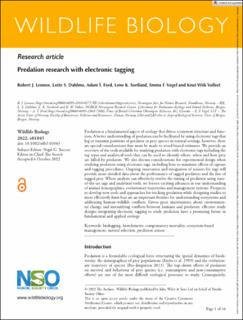Predation research with electronic tagging
Lennox, Robert J.; Dahlmo, Lotte Svengård; Ford, Adam T.; Sortland, Lene K.; Vogel, Emma; Vollset, Knut Wiik
Peer reviewed, Journal article
Published version

Åpne
Permanent lenke
https://hdl.handle.net/11250/3038753Utgivelsesdato
2022Metadata
Vis full innførselSamlinger
- Publikasjoner fra CRIStin - NINA [2364]
- Scientific publications [1392]
Originalversjon
10.1002/wlb3.01045Sammendrag
Predation is a fundamental aspect of ecology that drives ecosystem structure and function. A better understanding of predation can be facilitated by using electronic tags that log or transmit positions of predator or prey species in natural settings, however, there are special considerations that must be made to avoid biased estimates. We provide an overview of the tools available for studying predation with electronic tags including the tag types and analytical tools that can be used to identify where, when and how prey are killed by predators. We also discuss considerations for experimental design when studying predation using electronic tags, including how to minimize effects of capture and tagging procedures. Ongoing innovation and integration of sensors for tags will provide more detailed data about the performance of tagged predators and the fate of tagged prey. Where analysts can effectively resolve the timing of predation using state-of-the-art tags and analytical tools, we foresee exciting advances in our understanding of animal demographics, evolutionary trajectories and management systems. Prospects to develop new tools and approaches for tracking predation while designing studies to more effectively limit bias are an important frontier for understanding ecosystems and addressing human–wildlife conflicts. Given great uncertainties about environmen-tal change and intensifying conflicts between humans and predators, effective study designs integrating electronic tagging to study predation have a promising future in fundamental and applied ecology
